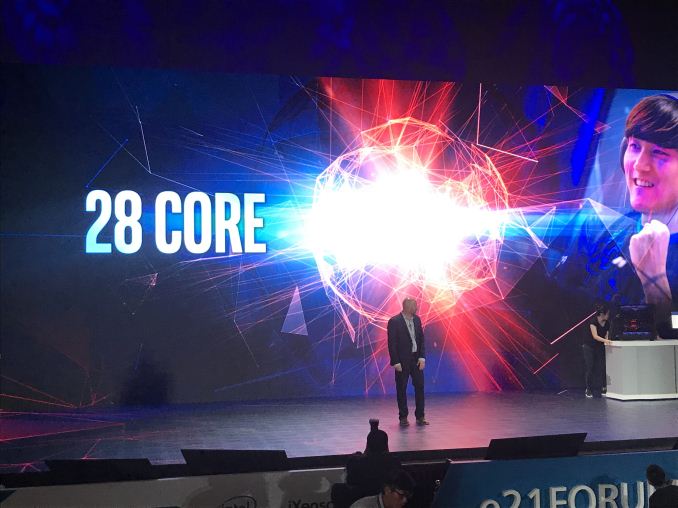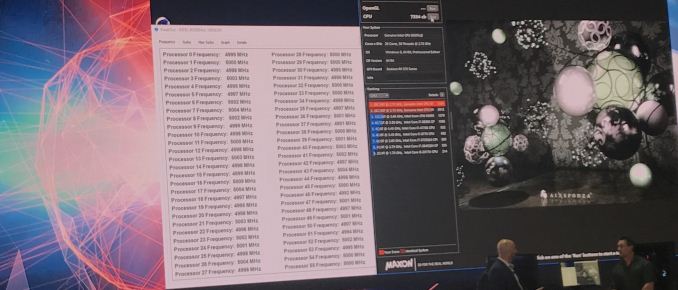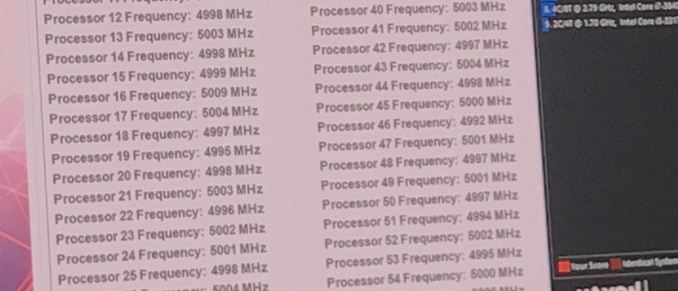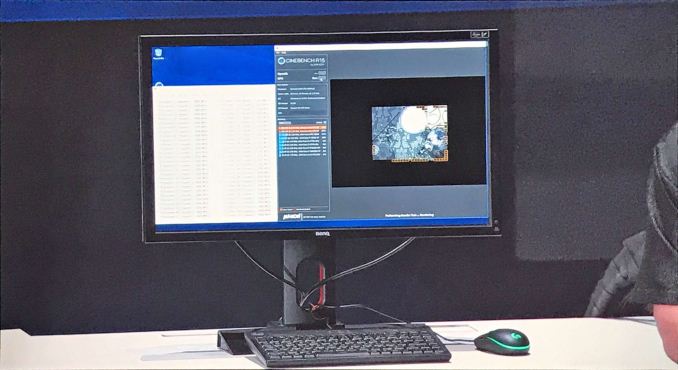Intel’s 28-Core 5 GHz CPU: Coming in Q4
by Ian Cutress on June 5, 2018 3:09 AM EST- Posted in
- CPUs
- Intel
- Trade Shows
- Computex 2018
- 28-core

Update 06/08: Intel has since backtracked on its initial statements, clarifying that while a 28-core part is coming in Q4 of this year, its stock frequency will not be 5GHz. Rather this was a (very poorly communicated) overclocking demo of the upcoming part. For more details, please see this article.
Alongside the launch of Intel’s first 5 GHz processor, the 6-core Core i7-8086K, Intel today also showcased a 28-core single socket machine also running at 5 GHz. The system on display scored 7334 in Cinebench R15, and Gregory Bryant (SVP and GM of Intel Client Computing Group) explicitly stated that it would be coming in Q4 this year.
No other details were provided, however for it to exist in a current platform, this new processor would likely be in LGA2066 (X299) or LGA3647 (the server socket). Intel technically already makes 28-core monolithic designs in the Intel Xeon Scalable Platform with the Xeon Platinum 8180, which is a $10k processor, which runs a lot slower than 5.0 GHz.
Personally, I feel this new processor is not a higher binned Platinum 8180. Going up from 2.8 GHz base / 3.5 GHz turbo to 5.0 GHz all-core frequency is a big step, assuming the 5.0 GHz value was not an overclock. I would fully expect that this is the point where Intel starts introducing EMIB to CPUs. (ed: FWIW, I disagree with Ian; my money is on a heavily binned 28-core XCC processor made on 14++. We've seen that Intel can do 5GHz on that process with the 8086K)
Last week I discussed the potential death of Intel’s low-end core design for high-end desktop, because it was being eclipsed by the mainstream parts. The only way Intel would be able to reuse the server versions of those low-core count designs would be to enable its embedded multi-die interconnect bridge (EMIB) technology to put two or more of the smaller dies on the same package. This would allow Intel do amortize costs in the same way AMD does by making use of higher yielding parts (as die size goes down, yield goes up).
Intel’s EMIB has a potentially high bi-directional bandwidth, so it would be interesting to see if Intel would bind two dies together and if there is any additional latency or bandwidth decrease with two dies together. With 28 cores, that would subdivide by two to 14-each, but not to four. So this processor is likely to be two 14-core dies using EMIB… which would actually be Intel’s HCC (high-core-count) processor design.
To add something extra to the mix, Intel might not be using EMIB at all. It could just as easily be the QPI interface on package, much how the company is using the Xeon + FPGA products announced recently.
So our primary questions to Intel would be:
- Monolithic or multi-die
- QPI or EMIB
- Socket
- Die size
- TDP / Power consumption at 5 GHz
TDP is a big part of the equation here. 28 cores at 5.0 GHz doesn’t come for free. The next questions are around price and launch date.
Additional:
There's the discussion about cutting into Intel's 1P market with such a product. But also, consider that at CES that Supermicro rated their X299 motherboards as supporting 300W processors, so it could easily correlate this processor to LGA2066 and a 300W TDP. That would be... fun... I guess?
| Want to keep up to date with all of our Computex 2018 Coverage? | ||||||
 Laptops |
 Hardware |
 Chips |
||||
| Follow AnandTech's breaking news here! | ||||||













87 Comments
View All Comments
Lolimaster - Thursday, June 7, 2018 - link
TR2 32core TDP is 250wAn 18core Skylake-X at 5Ghz draws well over 600w :D
cyberguyz - Friday, June 8, 2018 - link
And that does not count the stupidly huge power draw of the cooler.systemBuilder33 - Sunday, August 19, 2018 - link
Try 1500w, not 300w !!jjj - Tuesday, June 5, 2018 - link
They can't invest in a die that is HEDT only as that's very low volume so any solution needs to be using silicon that addresses more markets.Unlikely they go EMIB in server with 14nm and just 28 cores.
And did they indicate that this is sold as 5GHz all cores turbo and it's not an OC?
In any case, at Intel prices it's not of any relevance as it will likely be 10k$ or double that.
Gahl1k - Tuesday, June 5, 2018 - link
4GHz base clock, 5GHz turbo, yes, they indicated this.svan1971 - Friday, June 8, 2018 - link
fanboy do you want to stand by that comment? Take another sip of your LN2 cooled kool-aid first.cyberguyz - Friday, June 8, 2018 - link
Where? Look at the damn cooler on that demo and how fast they shut things down when AMD announced their 32-core Threadripper LOLChristopherFortineux - Friday, June 8, 2018 - link
Not to mention the Threadripper chip was running on air.Kevin G - Tuesday, June 5, 2018 - link
HEDT is more about marketing than high volume products. It is about winning at all costs. This helps sell products at the lower end of the product stack because you hold the performance crown.Though if they want to sell this as a consumer chip, it won't be for $10,000. Even for a server part, that price is asking a lot.
ChristopherFortineux - Friday, June 8, 2018 - link
This chip would be lucky to run even close to 5GHz in a traditional manor. It just is not going to happen.